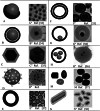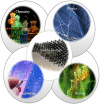Biosynthesis of bimetallic and core-shell nanoparticles: their biomedical applications - a review
- PMID: 30247125
- PMCID: PMC8676289
- DOI: 10.1049/iet-nbt.2017.0308
Biosynthesis of bimetallic and core-shell nanoparticles: their biomedical applications - a review
Abstract
Recently, researchers succeeded in designing and manufacturing a new class of nanoparticles (NPs) called hybrid NPs. Among hybrid NPs, bimetallic and core-shell NPs were a revolutionary step in NPs science. A large number of green physiochemical and methods for nanostructures synthesis have been published. Eventually, physiochemical methods are either expensive or require the use of chemical compounds for the synthesis of bimetallic and core-shell nanostructures. The main challenges that scientists are facing are making the process cheaper, facile and eco-friendly efficient synthesis process. Green synthesis (biosynthesis) refers to the use of bio-resources (such as bacteria, fungi, plants or their derivatives) for the synthesis of nanostructures. The popularity of the green synthesis of nanostructures is due to their environmental friendliness and no usage of toxic materials, environmental friendliness for the synthesis or stability of nanostructure. Bimetallic and core-shell NPs have many biomedical applications such as removing heavy metals, parasitology, molecular and microbial sensor, gene carrier, single bacterial detection, oligonucleotide detection and so on. The purpose of this study is to discuss briefly the biosynthesised bimetallic and core-shell NPs, their biomedical applications.
Figures








Similar articles
-
Biosynthesis of Nanoparticles from Various Biological Sources and Its Biomedical Applications.Molecules. 2023 Jun 2;28(11):4527. doi: 10.3390/molecules28114527. Molecules. 2023. PMID: 37299004 Free PMC article. Review.
-
Biogenic metal nanoparticles with microbes and their applications in water treatment: a review.Environ Sci Pollut Res Int. 2022 Jan;29(3):3213-3229. doi: 10.1007/s11356-021-17042-z. Epub 2021 Nov 3. Environ Sci Pollut Res Int. 2022. PMID: 34734337 Review.
-
An Overview of the Algae-Mediated Biosynthesis of Nanoparticles and Their Biomedical Applications.Biomolecules. 2020 Oct 30;10(11):1498. doi: 10.3390/biom10111498. Biomolecules. 2020. PMID: 33143289 Free PMC article. Review.
-
Prospects of algae-based green synthesis of nanoparticles for environmental applications.Chemosphere. 2022 Apr;293:133571. doi: 10.1016/j.chemosphere.2022.133571. Epub 2022 Jan 11. Chemosphere. 2022. PMID: 35026203 Review.
-
High-value utilization of egg shell to synthesize Silver and Gold-Silver core shell nanoparticles and their application for the degradation of hazardous dyes from aqueous phase-A green approach.J Colloid Interface Sci. 2015 Sep 1;453:115-131. doi: 10.1016/j.jcis.2015.04.053. Epub 2015 May 7. J Colloid Interface Sci. 2015. PMID: 25978558
Cited by
-
MXene-Chitosan Composites and Their Biomedical Potentials.Micromachines (Basel). 2022 Aug 25;13(9):1383. doi: 10.3390/mi13091383. Micromachines (Basel). 2022. PMID: 36144006 Free PMC article. Review.
-
Unveiling the role of novel biogenic functionalized CuFe hybrid nanocomposites in boosting anticancer, antimicrobial and biosorption activities.Sci Rep. 2021 Apr 8;11(1):7790. doi: 10.1038/s41598-021-87363-z. Sci Rep. 2021. PMID: 33833365 Free PMC article.
-
Biodistribution and Toxicological Effects of Ultra-Small Pt Nanoparticles Deposited on Au Nanorods (Au@Pt NRs) in Mice with Intravenous Injection.Int J Nanomedicine. 2022 Nov 16;17:5339-5351. doi: 10.2147/IJN.S386476. eCollection 2022. Int J Nanomedicine. 2022. PMID: 36415817 Free PMC article.
-
Greener synthesis of chemical compounds and materials.R Soc Open Sci. 2019 Nov 6;6(11):191378. doi: 10.1098/rsos.191378. eCollection 2019 Nov. R Soc Open Sci. 2019. PMID: 31827868 Free PMC article. Review.
-
A Review on Plant-Mediated Synthesis of Bimetallic Nanoparticles, Characterisation and Their Biological Applications.Materials (Basel). 2021 Dec 13;14(24):7677. doi: 10.3390/ma14247677. Materials (Basel). 2021. PMID: 34947271 Free PMC article. Review.
References
-
- Mortazavi S.M. Khatami M. Sharifi I. et al.: ‘Bacterial biosynthesis of gold nanoparticles using salmonella enterica subsp. enterica serovar typhi isolated from blood and stool specimens of patients’, J. Cluster Sci., 2017, 28, (5), pp. 2997 –3007
-
- Beitollai H. Garkani Nejad F. Tajik S. et al.: ‘Voltammetric determination of amitriptyline based on graphite screen printed electrode modified with a copper oxide nanoparticles’, Int. J. Nano Dimens., 2017, 8, (3), pp. 197 –205
-
- Jahani S. Beitollahi H.: ‘Carbon paste electrode modified with TiO2 /Fe3 O4 /Mwcnt nanocomposite and ionic liquids as a voltammetric sensor for sensitive ascorbic acid and tryptophan detection’, Anal. Bioanal. Electrochem., 2016, 8, (2), pp. 158 –168
-
- Jahani S. Khorasani‐Motlagh M. Noroozifar M.: ‘DNA interaction of europium(Iii) complex containing 2,2′‐bipyridine and its antimicrobial activity’, J. Biomol. Struct. Dyn., 2016, 34, (3), pp. 612 –624 - PubMed
-
- Niroomand S. Khorasani‐Motlagh M. Noroozifar M. et al.: ‘Photochemical and Dft studies on DNA‐binding ability and antibacterial activity of lanthanum(Iii)‐phenanthroline complex’, J. Mol. Struct., 2017, 1130, pp. 940 –950
Publication types
MeSH terms
LinkOut - more resources
Full Text Sources
Other Literature Sources

